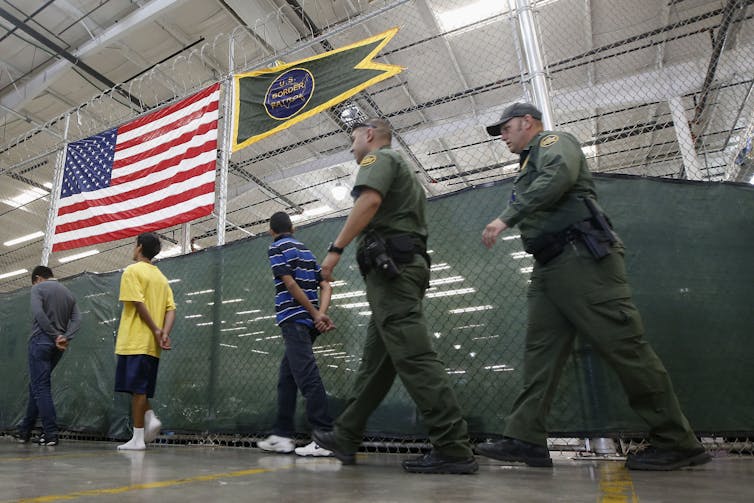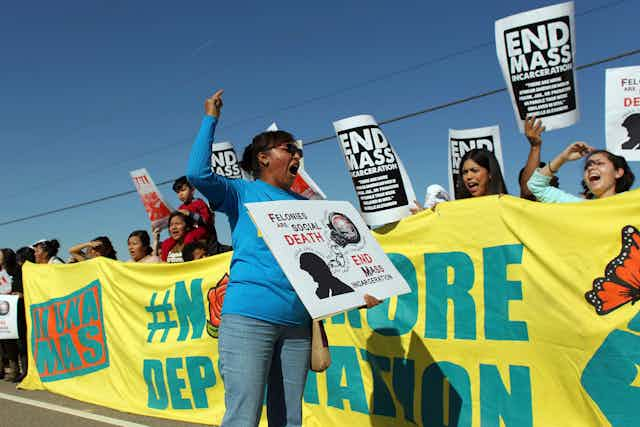President Donald Trump has followed through on his promise to ramp up immigrant detention as part of immigration enforcement. His executive order on border security and immigration describes a “new normal” that will include the detention of immigrants while they await removal hearings and removal.
Trump’s order expressly announces the end of “catch and release” of undocumented immigrants after their apprehension, which allowed them to post a bond and be released from detention while their removal proceedings moved forward.
Rather than doing something new, President Trump is simply expanding the use of immigrant detention. Immigrant detention has long been a tool in the arsenal of the U.S. government in immigration enforcement. It goes as far back as the detention of Chinese immigrants on Angel Island in San Francisco Bay, which began processing immigrants in the late 1800s. Detention of immigrants as a method of immigration enforcement saw an upswing at the tail end of the 20th century. In the 1980s, President Reagan’s administration used detention to discourage Central Americans, thousands of whom were fleeing civil wars, from migrating to the United States.
Other groups have also been detained on a broad scale. Several U.S. presidents responded to mass migrations of Cubans in the 1980s, who came in the Mariel boatlift, and Haitians fleeing political violence, with detention.
The Obama administration still allowed for noncitizens to bond out of custody while their removal proceedings were pending. But it also employed immigrant detention liberally – including the mass detention of Central American families. Obama set records for the number of removals during his first term.
The long history of detention has an equally long history of legal challenges. These are likely to continue in the Trump administration, which has made detention a cornerstone of its immigration enforcement plan.
History of immigrant detention
Courts have regularly been asked to intervene to curb the excesses of immigrant detention.
In 1989, during the administrations of President Ronald Reagan and later George H.W. Bush, a class action lawsuit was brought against the U.S. government by asylum applicants from El Salvador and Guatemala in Orantes-Hernandez v. Thornburgh. In class actions, a group of similarly situated persons band together to challenge a policy or practice.
In this case, the asylum applicants challenged mass immigrant detention and various policies that violated their right to counsel. The court found that the U.S. government had been transferring Central American asylum seekers from major urban areas where they could readily secure counsel to remote locations where they could not. The Ninth Circuit Court of Appeals affirmed a broad injunction barring the U.S. government from restricting access to counsel.
The Orantes-Hernandez decision was the culmination of a coordinated litigation strategy pursued by public interest lawyers to challenge the U.S. government’s treatment of Central American asylum seekers. Leading immigrant rights advocates, along with private law firms doing the legal work pro bono, planned the suits and divided up the work.
In a 1991 case, American Baptist Churches v. Thornburgh, the executive branch settled a suit brought by Salvadorans and Guatemalans. The plaintiffs claimed the U.S. government was biased against their asylum claims because the U.S. was allied with the governments in power in those countries. The settlement required the U.S. government to hear again the asylum claims of more than 100,000 Central Americans.
This line of litigation ultimately contributed to legislative reform.
In 1990, Congress passed legislation that created Temporary Protected Status for noncitizens who fled the violent conditions in El Salvador, and additional countries designated by the president. Temporary Protected Status has permitted thousands of noncitizens to remain in the United States until the violence has calmed.

Despite these successful challenges, the use of detention in immigration enforcement increased with the immigration reforms of 1996. Immigrant detention continues to be criticized – and litigated. For example, in response to an increase in women and children fleeing widespread violence in Central America, the Obama administration began detaining thousands of unaccompanied minors and entire families.
In Flores v. Lynch in 2016, the Ninth Circuit stated the detention of Central American minors was not required by law. However, the court did not protect parents from detention in the same way.
Class action for reform
U.S. immigration agencies have proved resistant to change. In an empirical study of immigration litigation in the 1980s, Professor Peter Schuck of Yale and attorney Theodore Wang concluded that the success of immigrants in class actions suggest the U.S. government’s immigration agencies are uncompromising. They are enforcement-oriented to a fault, they said.
Recent years have continued to see challenges to immigration detention. In Jennings v. Rodriguez, the Supreme Court currently has before it a class action raising the question of whether immigrants, like virtually all U.S. citizens placed in criminal detention, must be guaranteed a bond hearing and possible release from custody. This case challenges, on constitutional and statutory grounds, lengthy immigration detentions without any opportunity for release.
Detention appears as if will be an important part of Trump’s immigration enforcement plan. As historically has been the case, legal challenges will almost certainly follow.

